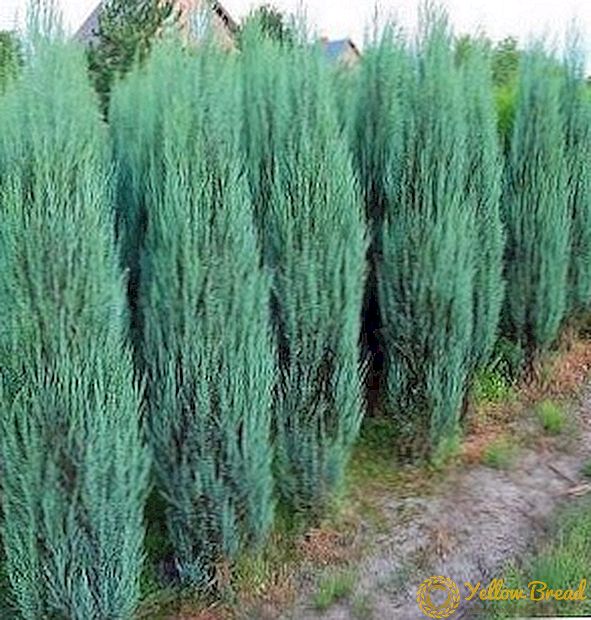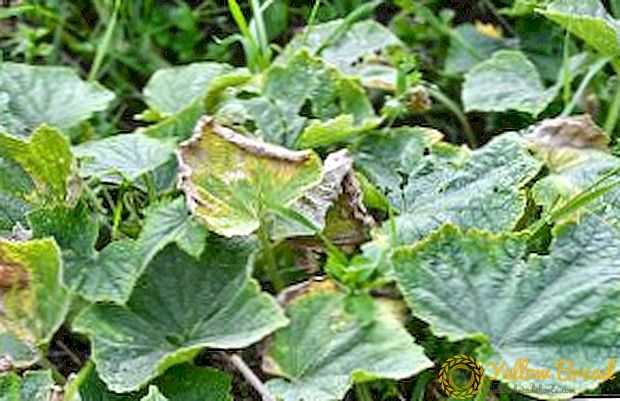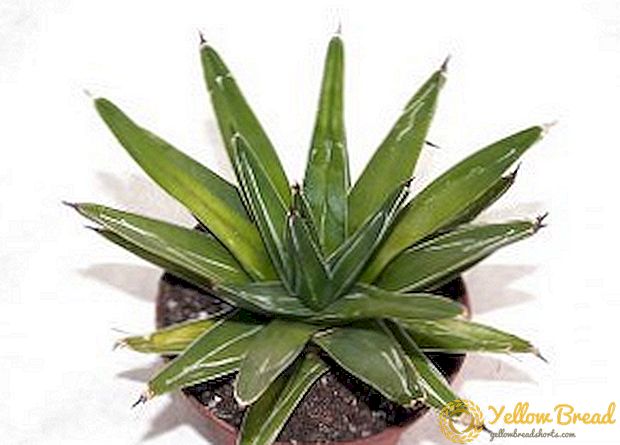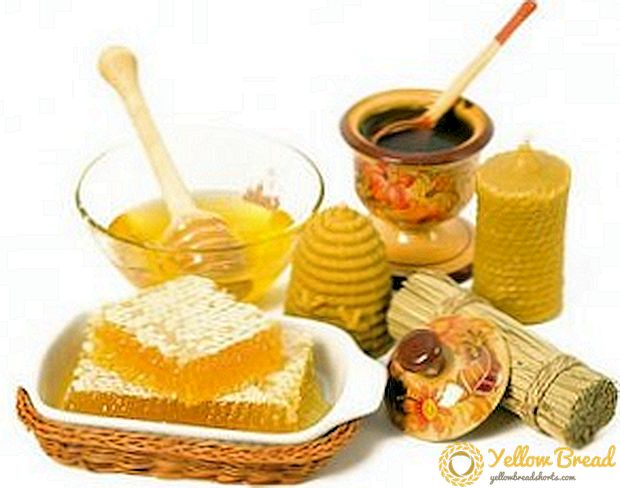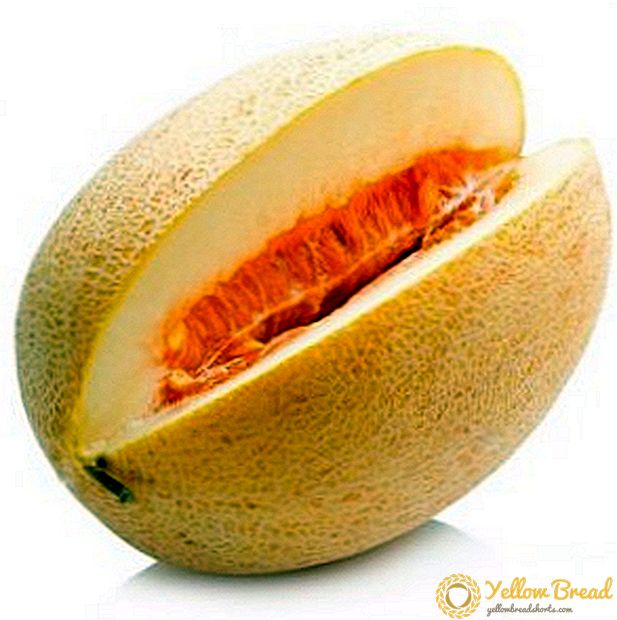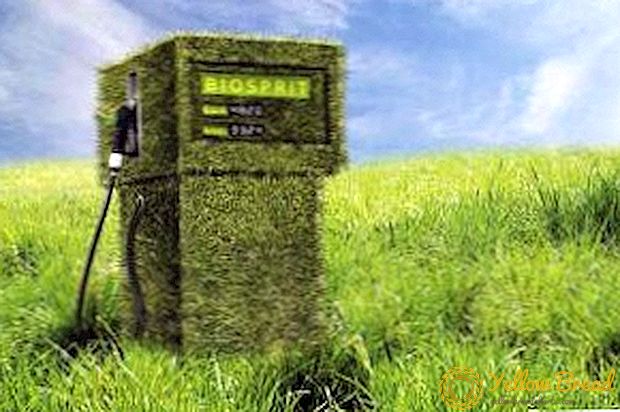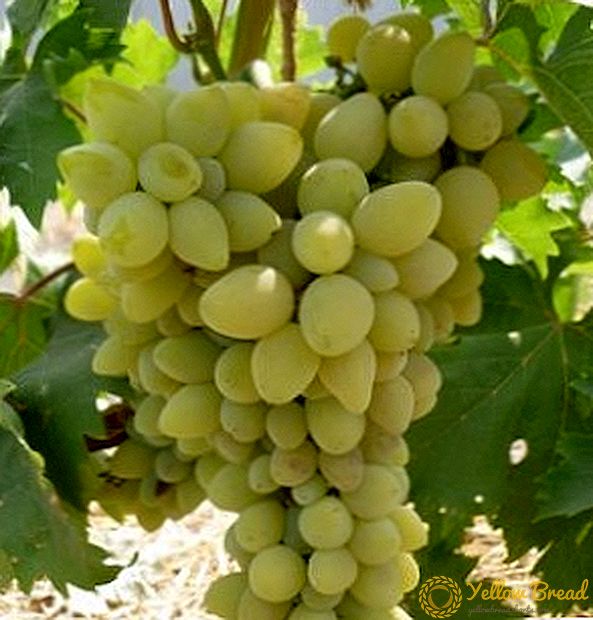
Grape culture has long been known for its healing and beneficial properties.
In addition, her gorgeous vine in the summer gives a cool, cozy shade and helps to create peace and comfort near the house.
In order to grow a decent and beautiful plant of grapes, it is necessary to determine the variety, which is most suitable locality.
As well as their wishes for the variety itself (juiciness, sweetness, color and size of the berry, strength of growth and other characteristics).
- Description of the variety
- Clusters
- Yield
- Term ripening
- Merits
- disadvantages
- Landing features
- Preparing for landing
- Pit for planting grapes
- Landing process
- Timing
- Care
- Watering
- Mulching
- Harboring
- Pruning
- Fertilizer
- Protection
Description of the variety
Galahad grape variety is a type of grape plant, which was obtained from the crossing of three grape varieties: Talisman, Vostorga and Vostorg Moskatnogo. Culture is a complex-resistant dining hybrid grape form.
Clusters
The cluster of Galahad is very large, moderately dense grony, 600-1100 g each. They all have a cylindrical shape.Egg-oval very large fruits (10-12 g) of Galahad are colored amber-yellow, filled with fleshy pulp, and are covered with not very dense skin. The taste properties of this variety are very high, since its berries are sweet enough and not very sour.

Yield
The grape varieties Galahad very harvested. It is well pollinated annually, which allows you to start a large number of berries. At the same time, the wasps do not like Galahad berries, and do not damage them. This variety brings huge yields. But there is one important feature. The first fruiting of Galahad, although it is very abundant, is forcedly limited to the relief of a young vine. And already the subsequent harvests are collected in full.
Term ripening
Galahad is a grape variety that has the earliest ripening period. It ripens until the end of July, within three to three and a half months from the moment of the dissolution of the first buds.
Merits
This culture is considered the most promising among the grape varieties today. Galahad is a strong-growing and disease-resistant, including fungal, variety of grapes. It is resistant to pests.This variety is more winter-hardy, and tolerates lowering the temperature to -25 degrees. Well rooted and has a high survival rate of cuttings. Berries do not burst and do not rot, which allows you to harvest in full. Fruits tolerate transportation as well.
disadvantages
Galahad grapes have almost no flaws. The only thing that is a feature of this variety is the tendency to dropping ripe berries from the grapes.
Landing features
Preparing for landing
Breeding grape variety Galahad and seedlings and cuttings. Even its green cuttings, rooted out in July by the stepson, take root. And they do this by placing dangling grape branches in a jar filled with plain water. For fruiting vines, grape branches must be cut annually by 7-8 buds.

Planting grapes, it is necessary to correctly determine the place for its growth. It should be well lit, and close to it should not grow large trees, as they obscure the desired area. For this reason, the vineyard is not organized in the center of the garden, and choose for him the warm, southern corners of the site.You can plant a plant and near the walls of the house, while departing from them one and a half meters.
For planting grapes, always choose cuttings with a developed root system. Evidence of this is the natural fall of the leaves from the plant in the autumn. It is forbidden to allow the drying of the roots of seedlings, and for this they are wrapped in a talker of clay. In the winter, the plant is dripped with earth, and in such a state it remains until spring, when it can be planted on the planned growing area.
Before planting, the seedling is properly prepared. To this end, the roots are refreshed with a sharp shears, which are then dipped into the mash. If there are two shoots in the shoot, the one that is stronger is left, and the weak is removed, while the strong is cut off to two or three buds. Now the sapling is ready for planting.
Pit for planting grapes
When planting a vine plant, it is necessary to trace the preparation of the pit for it. Planting recesses for all bushes and trees are prepared in advance. Thus, if the planting is planned for spring, the hole is prepared from autumn, while in the autumn it is filled with half of the substrate from soil and fertilizers.If landing is convenient in the fall, then deepenings prepare in the summer.
For seedlings grape plants are dug grooves 40-50 cm, while its total size should be about 80 cm in volume. It is in a pit of this size that nutrients can be poured in the amount that is enough for growth and the first fruiting of a crop. If you make the hole smaller, the plant will grow poorly and slowly grow. The shape of the pit, at the same time, digs any form (square, round), it does not matter.
After the hole is dug, prepare filling her for a mixture of soil. Half of the pit is filled with the top layer of soil dug out of the recess, mixing it with a mass of humus, ash and superphosphate. And if the soil is clay, then sand is added in equal quantity with the ground. It is produced for good penetration of oxygen and moisture into the soil. Ash and humus are introduced in the amount of 2-3 buckets per pit.

If the seedling is planted in a newly dug hole, then the soil, which is below the rhizome, is well compacted, so that over time, when the ground sits, the roots do not break.We put the seedling in the recess so that the root system is 30-40 cm deep, and sprinkle it on 10 cm with the soil that was covered under the roots, and then we fill the pit with the soil removed from the recess.
At the same time, all the time we pour water into the pit and compact the soil in it. The pit is not completely fall asleep - this can lead to the development of root growth. Near the seedling, in a circle we will leave 5-10 cm of the hole, 30 cm in diameter. If the planting soil is sandy, the planting depth increases and is 55-60 cm. This depth prevents the rhizome of the plant from freezing into seasonal cold.
Experienced gardeners recommend determining the level of soil water in the area before planting a crop of grapes. It is not advisable to plant grapes on the ground, where the groundwater is at a five-meter distance from the surface.. For all varieties of a grape plant, the most important thing in growth is the timely ripening of the vine, which must occur before the onset of frost.
And so, as the close location of water contributes to the rapid and abundant growth of the shoots of the culture, its branches do not have time to mature at the right time, and in freezing temperatures, the buds die.
Landing process
When planting a grape bush, remember that this is a liana family, and therefore a plant needs a support, to which it can be tied up later. For this purpose, it is necessary to leave space for the insertion of several supports, between which the wire will be stretched. The shoots of the plant will be tied up to it, and the whole bush will subsequently be placed.
There are still several interesting landing methods, using which it is possible to achieve early fruiting and the fastest development of a grape bush. This is a container planting method. It is considered the most effective, although a little time consuming, but the results are worth it.

Following this method should be planted cuttings not in open ground, but in a cardboard box, or a thick plastic bag without bottom and top. Capacity should be large enough, about 10 liters volume. Roots should not reach the walls. Plant the plant according to the rules in open soil. Then, for ease of movement, the container is placed in a low box, which, together with the plant, is placed in a warm corner.
After a while, the cuttings will begin to grow, and after the buds have dismissed, it is necessary to leave the two best, remove the rest, and move the container to the window sill. At the same time you need to choose a place warm and bright.After warming outside, at the same time the weather should be already steadily warm, the box is carried out to the street.
First, for stabbing it is put in the shade, and then slowly moved to a lighter place, while regularly watering. When the threat of spring frost is over, seedlings are transplanted to a place of constant growth.
Many use another simpler proven landing method. Approximately 14 days before planting, the roots are pruned a little on the cuttings. Then the seedlings are placed in sawdust (10 seedlings in one container), pre-steamed, and this is all put in a warm place. After 14 days, seedlings should grow.
During this period, the earth is already warm and can be planted in previously prepared soil. This procedure increases the growing season of the bush for the calendar month, while the vine will ripen early, and by next year the culture will delight the first berries.
Timing
Transplanting and planting grapes produce in autumn and spring. In the spring bushes are planted in open soil in the middle of May. Then, when stable warm weather is established and the temperature of the earth at the depth of a dug pit, will be at least 10 degrees.In cardboard boxes and containers of plants planted in April. In the fall, a grape plant is planted before the onset of the first frost, and this is the month of November.
Care
Like any other plant, grapes require attention and care. There are some features of the care of the culture of grapes. Care includes stages such as watering, mulching, hiding, pruning and fertilizing. All of these steps are indispensable and vital for the plant. Without them, the vine will grow badly and bear fruit, and in some cases may even die.
Watering

A very important step in the care of the vineyard is the correct and timely watering of this plant. Excessive moisture in the ground displaces oxygen from it, and the roots of nitrogen deficiency can fester, and this will lead to the death of the plant. Watering the grapes, take into account the phases of the growing season and culture. He needs grapes when buds bloom, after flowering, during the ovaries and growth of fruits. If there is a drought outside, the grapes save by watering irrigation before hiding it for the winter period.
The rate of water for watering a bush is 30-40 liters, and is made with periodicals 1 time in 7 days. If the weather is hot, watering increases up to 2 times. The grapes are recommended to be watered in special, pre-prepared pits, called drainage.
Mulching
Mulching of the soil under the grapes is carried out in order to preserve a sufficient amount of moisture in the ground for a long time. Mulch the ground in spring. Produce it rotten straw, fallen leaves, weeds, sunflower husks, compost. These mixtures are laid out on the soil under the grapes in a thick layer, then thoroughly watered. Thus, the mulch is compacted, settles, and will retain the moisture necessary for the plant for a long time.
Mulch is also an additional protection for the rhizome of the plant from winter temperatures. Therefore, in the fall, its condition is checked and, if necessary, additional trench mulching is produced.
Harboring

Grapes belong to crops that come from temperate warm climates. is he very sensitive to seasonal cold. The most tender parts are green young sprigs of grapes. They already react to the temperature of -1, -2 degrees.Buds of the plant are less sensitive, but the danger of them is the winter temperature drops.
In such a period, shoots lose their so-called hardening, and even a small drop in temperature can destroy them. Not frost-resistant and the root of the plant.
Given these features, grapes are attributed to plants, more demanding, sheltering for the winter. It is produced in the month of October, before the first minus temperature drops. Before harboring the grapes are pruned. Cover the plant with polyethylene, special material, or snow and earth.
Pruning
The crop is pruned to form a bush (this is the first four to five years of growth of a young seedling), to regulate the volume of the crop, and to prevent it from thickening and maintaining the crown. Pruning produced in spring and autumn. And it is also possible thinning and plucking stepchildren in the summer.
Autumn cutting is tolerated by the plant less painful, as this prevents the spring "weeping" of the vine. But during such pruning it is necessary to leave a supply of evenings on the plant, since it is possible that they will be damaged during wintering, shelter for hibernation and disclosure after it.
Fertilizer
The vine is a perennial plant that grows in one place.Therefore, it chooses from the soil over time all the useful elements that it needs for development, fruiting and growth.
Bushes are fed with fertilizers in autumn and spring. When feeding a plant, it is necessary to combine fertilizers correctly, and to apply them during certain vegetative periods. The amount of mineral micronutrients required by the grape is calculated based on the size of its yield. In addition, organic fertilizers are applied to the soil, which include humus and compost mass, peat and bird droppings.
Wherein the main fertilizer from a number of organic, manure is considered various domestic animals, or compost, which is specially prepared in advance in a separate area.

Organics contribute in the autumn, and nitrogen and phosphorus elements are fed in the spring. To achieve the maximum effect, fertilizers are diluted with water and applied to 40-60 cm depth in the rhizome zone, and this is a radius of about 1 m.
Protection
Vine protection produce chemicals. The purpose of this treatment is to prevent the appearance of various kinds of pests and diseases on the plant. After all, everyone knows that it is always easier to prevent a disease than to treat an already occurring process.
From mildew bushes are treated with a Bordeaux mixture, also a 3% oxychloride solution of copper is also excellent. Even from the billions and pests in the fall, the ground near the bush is sprayed with nitrafen. To do this, take 3% of its solution. For this, the soil is mulched. Nitrafen can still scare off mice and other rodents.
From oidium grapes protect potassium manganese, which is added to the top dressing foliar. Also, protects against the disease and mullein (its solution), as well as colloidal or ground sulfur. Any processing of bushes should be made before flowering or after it.
From mice and other rodents, the plant will help protect a felt piece, a felt boot or pure wool, which has been burned before it, placed under the winter film. Mice are also not happy with the smell of rubber crumbs.

